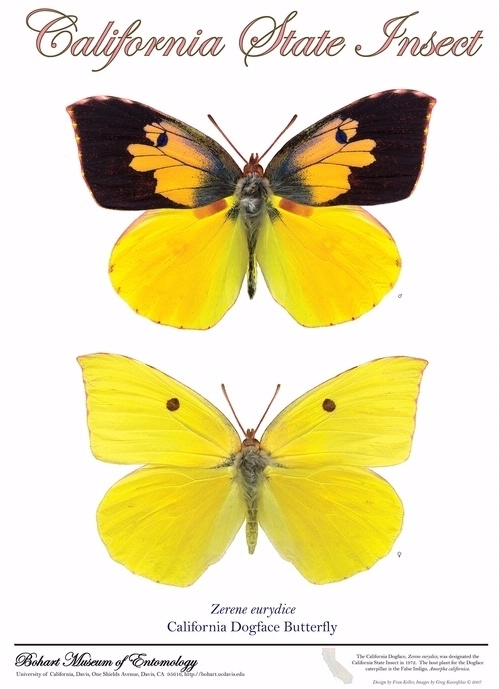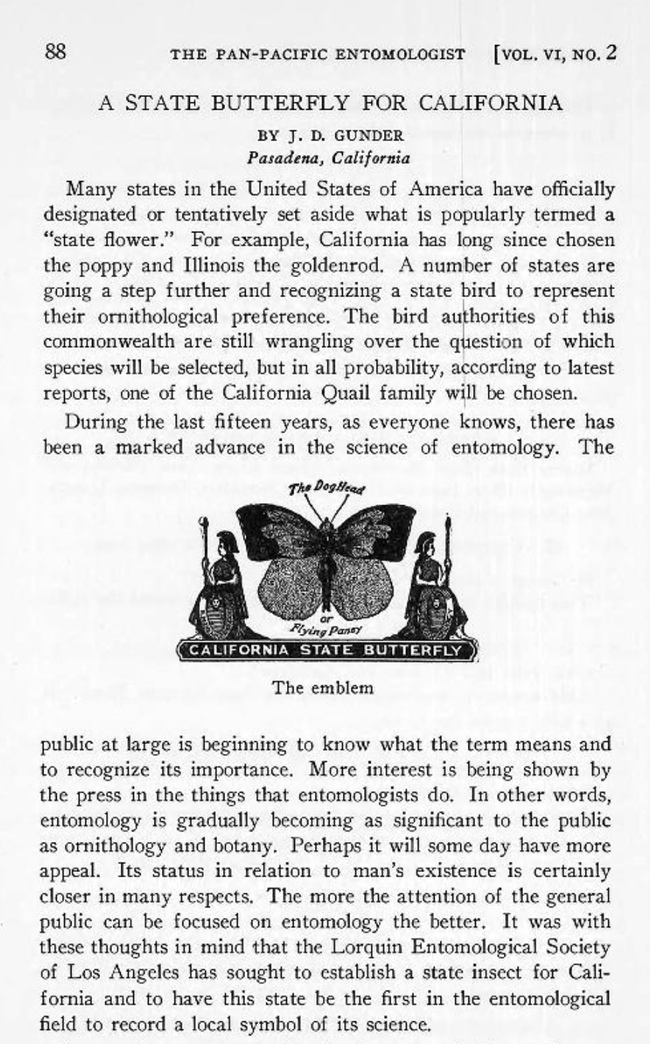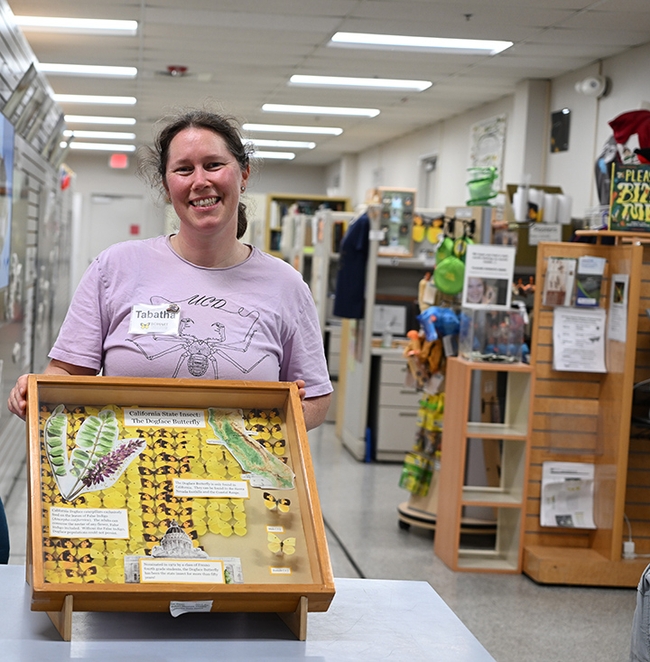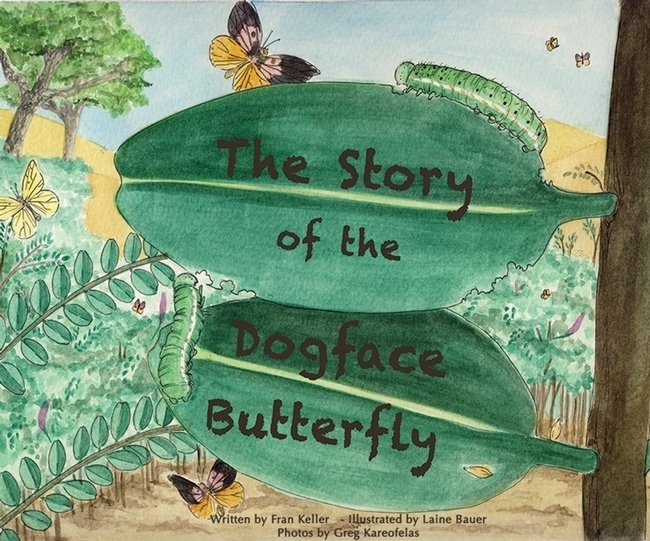
Did you know that California has a state insect? It does.
Is it the honey bee? No.
Is it the lady beetle (ladybug)? No.
Bumble bee? No.
It's the California dogface butterfly (Zerene eurydice), an insect found only in California.
The state Legislature designated it as the state insect in 1972. The butterfly is nicknamed "dogface" in reference to the silhouette of what resembles a poodle head on the wings of the male. The female is mostly solid yellow except for a single black spot on its upper wings.
Most people have never seen it in the wild. But if you've visited the Bohart Museum of Entomology at UC Davis, home of a global collection of 8 million insect specimens, you know that its logo is the California dogface butterfly.
And on Thursday, Aug. 8 those attending the Vacaville Museum Guild's Annual Children's Party (sold out) will see specimens from the Bohart Museum, as well as macro images of the butterfly, the work of talented Bohart associate Greg Kareofelas of Davis.
Tabatha Yang, education and outreach coordinator of the Bohart, has donated a drawer of the specimens for visitors to see. They can also pose in a cutout of the Bohart Museum's California dogface butterfly banner. And thumb through a 35-page children's book, "The Story of the Dogface Butterfly," written by UC Davis doctoral alumna Fran Keller, a professor at Folsom Lake College and a Bohart Museum research scientist. The book includes images by Kareofelas and Keller. Laine Bauer, then a UC Davis student, contributed the illustrations.
The book, published in 2013, tells the untold story of the California dogface butterfly, and how schoolchildren became involved in convincing the State Legislature to select the colorful butterfly as the state insect. Fourth grade students of Betty Harding and Shirley Klein, Dailey Elementary School, Fresno, advocated it as the state insect. The teachers and students enlisted the help of State Assemblyman Kenneth L. Maddy, who authored AB 1834. On July 28, 1972, Governor Ronald Reagan signed the bill into law, designating the California dogface butterfly the official "State Insect of California." (Read more on how the butterfly became the state insect under the Ronald Reagan administration.)

The most prevalent habitat of the California dogface butterfly is the 40-acre Shutamul Bear River Preserve near Auburn, on a Placer Land Trust conservation site; Kareofelas serves as a docent on the Placer Land Trust tours. (See virtual tour on YouTube). The butterfly is there because its larval host plant, false indigo (Amorpha californica), is there.
Are there dogface butterflies in Vacaville? Yes. The butterfly's breeding grounds include Gates Canyon. (See UC Davis emeritus professor Art Shapiro's website.)
As mentioned, few people see the butterfly in the wild. However, its image graces a first-class U.S. stamp and California driver licenses. It's also depicted on the California State Fair monorail.
Butterfly Poster and Book. The Vacaville Museum Guild's Children's Party (see what's on tap) also will spotlight a Bohart Museum poster by Kareofelas-Keller that depicts the male and female butterfly. (Both the poster and the book are available for sale in the Bohart gift shop; net proceeds benefit the insect museum's education, outreach and research programs.)
The Bohart Museum, located in Room 1124 of the Academic Surge Building, 455 Crocker Lane, also houses a petting zoo (featuring stick insects, Madagascar hissing cockroaches and tarantulas) and a insect-themed gift shop, stocked with books, posters, t-shirts, hoodies, jewelry and collecting equipment. Director of the insect museum is Professor Jason Bond, the Evert and Marion Schlinger Endowed Chair, UC Davis Department of Entomology and Nematology, and associate dean, Agricultural Sciences, UC Davis College of Agricultural and Environmental Sciences.
The Bohart is open for walk-in visitors on Tuesdays from 9 a.m. to noon and from 1 to 4:30 p.m. through Aug. 27. It will be closed to the public Sept. 1-22.
The next open house is set for 1 to 4 p.m., Saturday, Sept. 28. The theme is "Museum ABC's: Arthropods, Bohart and Collecting." All open houses are free and family friendly. Parking is also free. For more information, contact bmuseum@ucdavis.edu or access the website at https://bohart.ucdavis.edu.
Links:
- Golden Year for the California Dogface Butterfly (Bug Squad post, Feb. 4, 2022)
- Rob on the Road, KVIE, Public Broadcasting Service (PBS) (First aired July 7, 2017)
- Capital Public Radio Piece on Dogface Butterfly (featuring Greg Kareofelas)
- Pacific Land Trust website (PLT maintains a conservation site in Auburn that's the home of the California dogface butterfly)
Attached Images:

Tabatha Yang, education and outreach coordinator for the Bohart Museum of Entomology, holds a drawer of California dogface butterfly specimens. The butterfly is California's state insect. (Photo by Kathy Keatley Garvey)

A 35-page children's book, "The Story of the Dogface Butterfly," is authored by UC Davis doctoral alumna Fran Keller, a professor at Folsom Lake College and a Bohart research scientist.